For some of us of a certain age, recalling the 1960s and 1970s rekindles recollections of passionate pursuits of cars we desperately wanted though not necessarily needed. In those days the path to finding a used high performance or collectible car passed through the dog eared pages of the regional Want Ad Press, the local newspaper classifieds or the classified section of the Sunday New York Times. Except for national magazines (Well beyond consideration for most of us) nothing else existed except maybe the bulletin board at the entrance to the local auto parts store, back when locally owned parts stores existed.
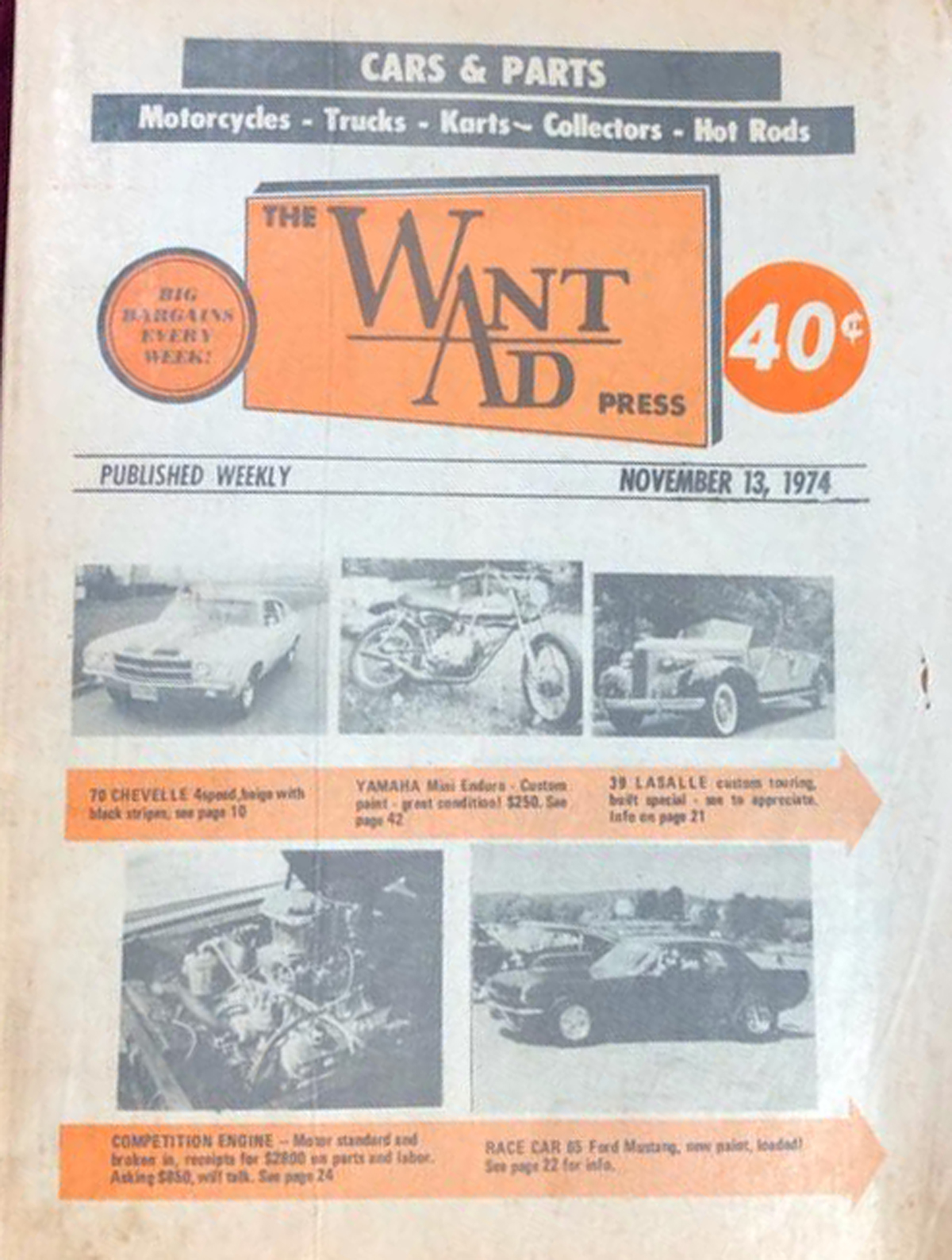
Want Ad Press
Back then good cars when advertised were gone in hours. Wildly eager to beat everyone else to that clean Corvette or 240Z or whatever it was that made our pulse race, we would impatiently troll the newsstand waiting for the bundle of Want Ad Presses to land at the curb. I personally spotted and followed a New York Times delivery truck until it reached its next stop at Rockland Stationers in Teaneck New Jersey to toss out its bundles of Sunday editions that contained the precious latest auto classified ads. It was 1:00 am on that Sunday morning.
Today the classic car buying world would be unrecognizable to our bell bottomed selves of yesterday. Choices of platforms for making vehicles available for sale fill communications channels some of which did not even exist a few years ago.
With that in mind Drivin’ News will take a look at today’s marketplace and compare the platforms now available for finding the vehicle we want. To help us in our journey will be friend of Drivin’ News, owner of Motorcar Manor and experienced classic car sales agent Matt Maisano.
Comparing classic car sales platforms
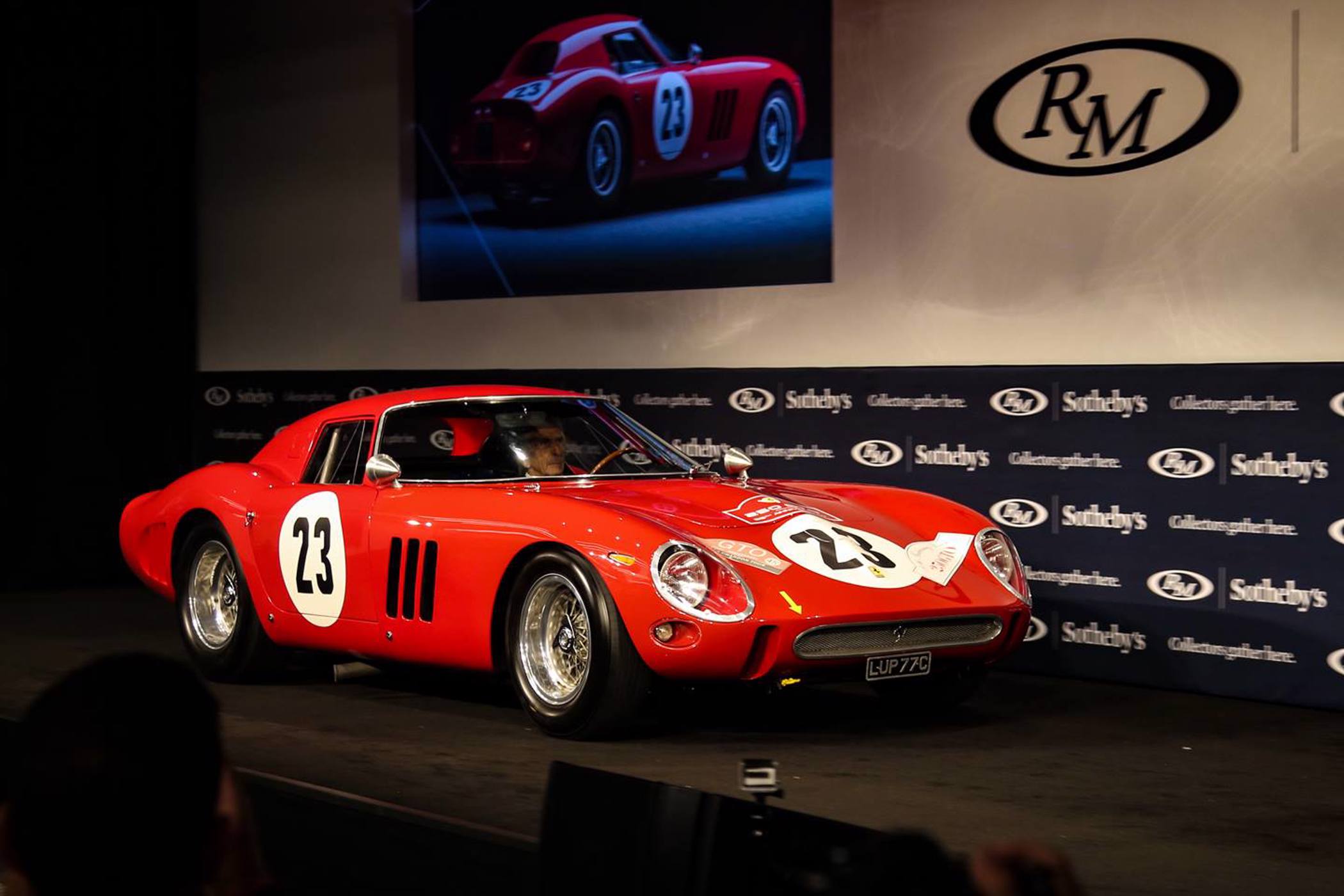
RM Sothebys auction
Today, whether looking to sell or to buy a classic or performance vehicle, the variety of platforms available offer significant choices far beyond anything we dreamed of in our early car buying days. A broad array of venues utilizing the full spectrum of available media exist with each platform possessing its own unique personality designed to appeal to a market segment with specific characteristics.
The mind boggles when considering how many classic vehicles change hands every day and the vast amounts of money associated with those transactions. It does not boggle the mind of any sentient being that with this vast amount of money in play that the number of platforms for advertising, promoting and facilitating these transactions in recent years has exploded. As always, with the introduction of choice comes the potential for confusion. In the days of the classified ad, the choices were few. Basically it fell to deciding what publication to choose for placing a few lines of copy and should a few extra dollars be spent to include a fuzzy black and white photo.
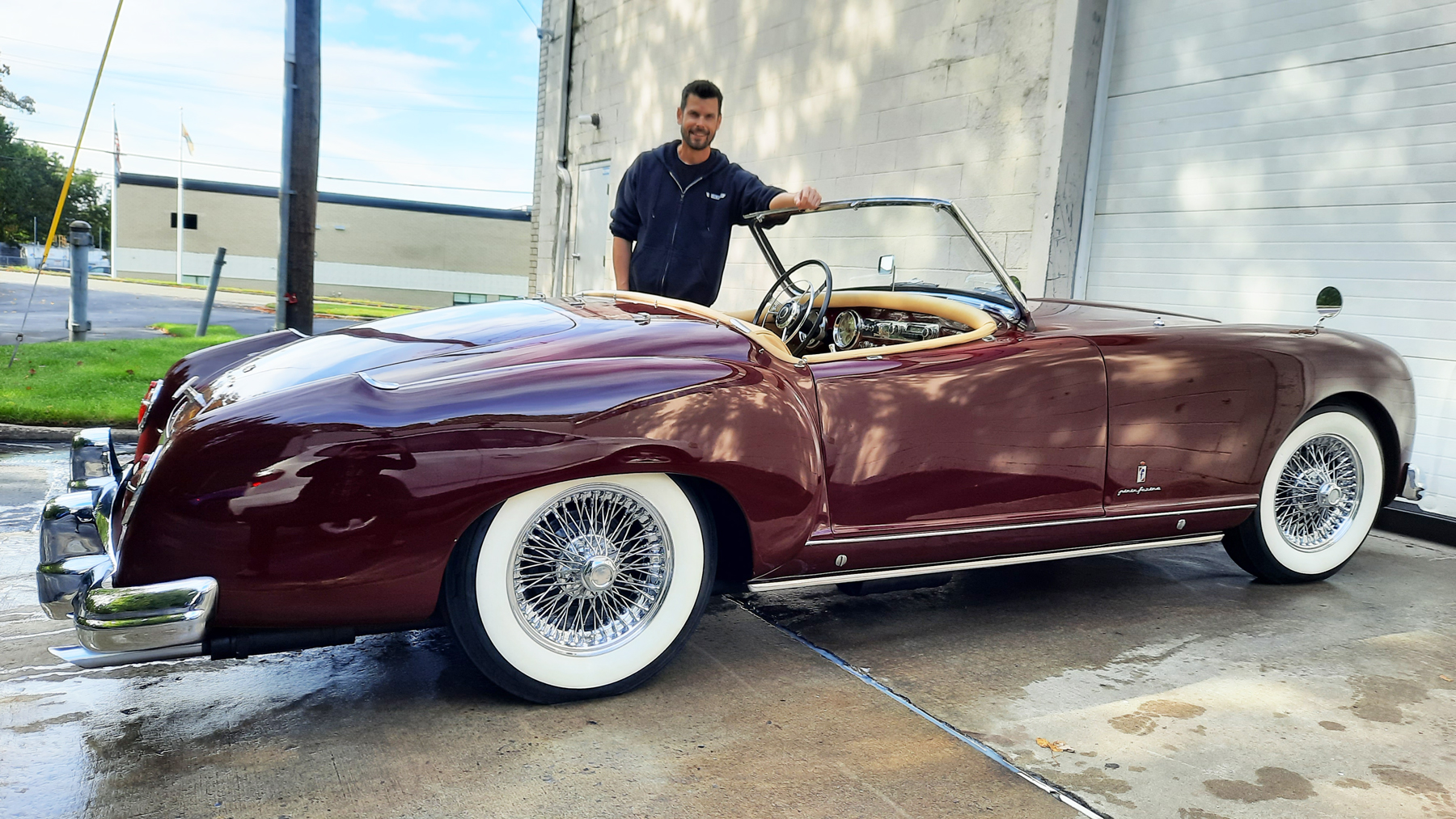
Matt Maisano of Motorcar Manor with Nash-Healey headed to Bonhams auction in Greenwich
Today websites, on–line auctions, in-person live auctions, social media (Facebook Market) and some print offer what can be a confusing constellation of choices when considering the best place to buy or sell a specific vehicle.
Matt Maisano of Motorcar Manor has for over a decade provided concierge services for classic and performance car enthusiasts looking to buy a car or sell a single car or a collection of classic cars.
Matt has extensive experience counseling on the purchase and sale of premium vehicles across the full spectrum spanning from vintage Ferraris, Lamborghinis, Porsches and Maseratis to American Muscle cars and low volume special edition vehicles such as Nash-Healeys and Kaiser-Darrins.
When asked about the state of the market, Matt simply says, “The classic car market is insane. Cars are selling like crazy.” Matt also says, “What some call modern classics are skyrocketing.” Matt considers Modern Classic Cars dating from 1982 on. He acknowledges that most consider the starting date as 2002. Matt’s opinion about the overall market is mirrored by the latest Hagerty Market Rating for September 2021. Hagerty says, “As we near the end of the second Covid Summer, it’s amazing the difference a year can make. This time last year, the rating was at an all time low, but now the Hagerty Market Rating has increased for a sixth consecutive month to its highest point in over 5 years. After a strong showing at Monterey, auction activity is back to pre-pandemic levels and optimism among our industry experts is at its highest point in over seven years.”
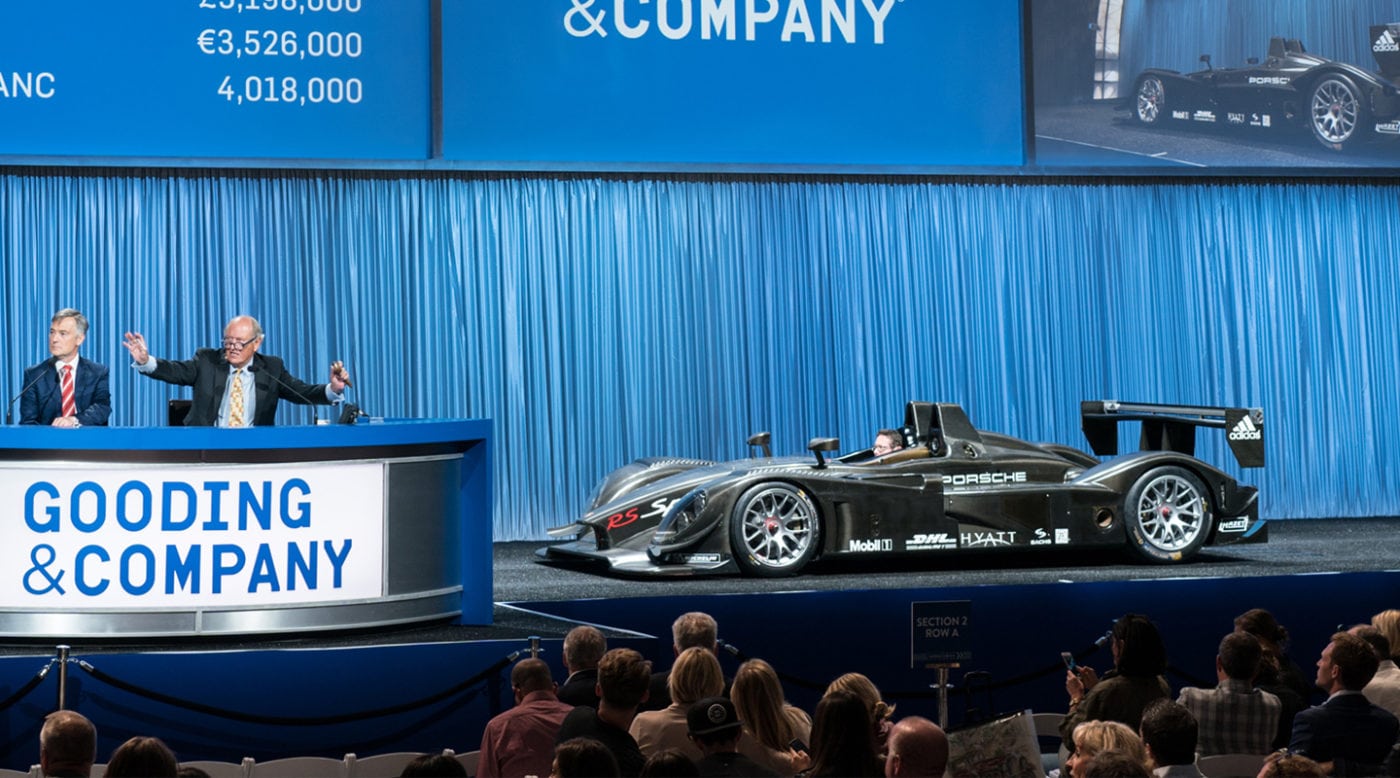
Gooding Company Auction
Without a doubt the expanded democratization of the buying process has benefitted from Covid’s creation of legions of bored, house bound people. Exploring the web, these home bound denizens of the internet armed with computers and money discovered the excitement of online bidding. Game on. An equally important contribution to expanding the market has come courtesy of the increasing number of venues affording access to the buying and selling process and the ease each brings to that process.
Clearly, today, websites and live in-person events dominate the business of selling collectible vehicles. They have almost totally replaced print. Websites, on-line auctions, live auctions and to some degree social media in the form of Facebook Market presently reign as the preeminent players.
While the opportunity still exists to place an ad in print, newspapers and penny savers no longer have much value. Print ads are best placed in auto themed national publications, marque specific club publications and the still reigning king of print car ads, Hemmings Motor News. While Hemmings Motor News still stands as a worthy go-to resource, most other placements do not have the broad reach of the web or pack the concentrated sales power of an auction whether in-person live or online.
For the lower end of the market websites are where much of the action is. Sites like eBay, Facebook marketplace (Craig’s list), Classic Car.com. and Classics.Auto Trader.com offer affordable access to mostly five figure collectibles.
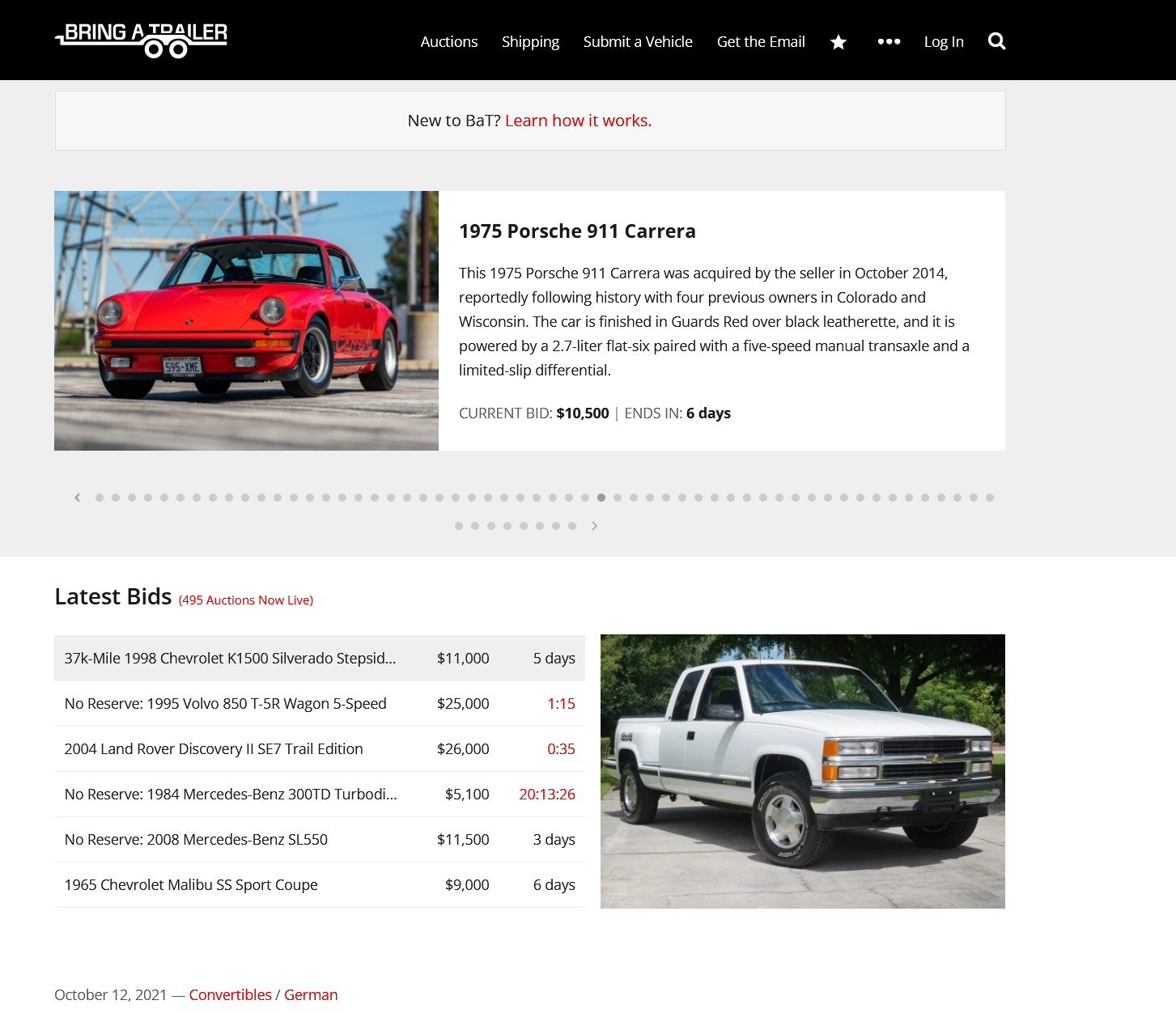
Bring a Trailer website
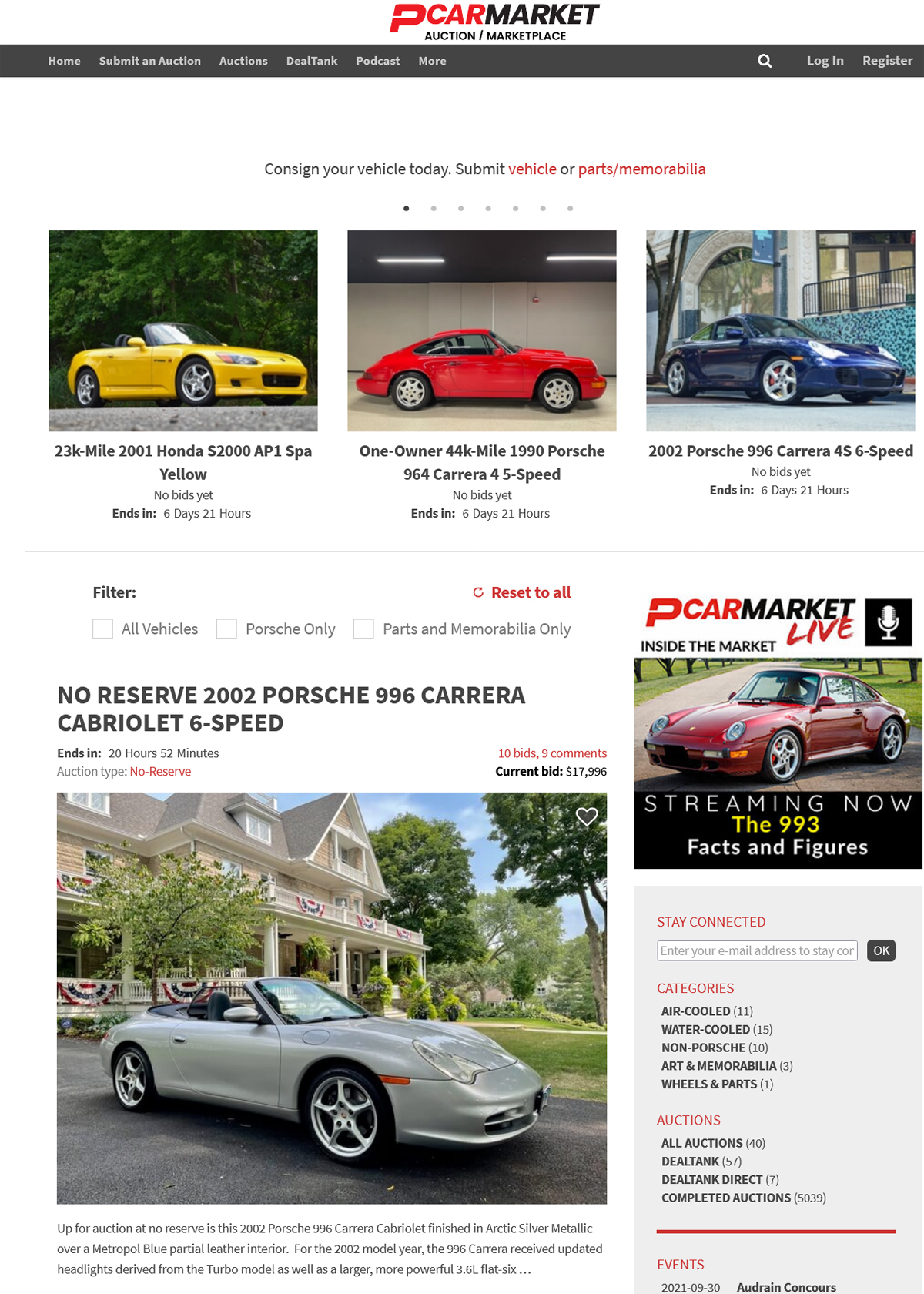
P-Car Market website
Certainly some sites rank higher, sometimes, significantly higher than others. Two that have lost much of their early luster are eBay and Craig’s List. eBay, infected with so many scams, and petty annoyances has turned a lot of people off. Though it still has national reach it has suffered from a considerable decline in respect and business. As for Craig’s list, Facebook Marketplace basically has eaten Craig’s lunch. Facebook Marketplace offers a lot of vehicles and benefits. Most significantly it integrates with Facebook’s huge audience’s social media activities. With people constantly on their phone it offers a powerful opportunity for passive exposure. Most appealing, it costs nothing.
Classics.Autotrader.com provides a collectibles version of the traditional Autotrader site. Both work the same way. When looking for a vehicle one simply keystrokes in the what you are looking for and the site calls up any matching vehicle from its large inventory of actively available cars.
However, significant short comings exist for these low cost platforms that can hinder getting a true a understanding of the vehicle. Content suffers from the amateur writing and photographic skills of most individuals placing the ads. Information is incomplete compared to on-line auctions or in-person auctions. Supporting photographs are few, maybe 30 at most. Asking price often suffers from amateur best guesses or hopeful dreams. As well placing a car on the site can produce a frustrating bevy of time wasting tire kickers and robocalls offering to help sell your car.
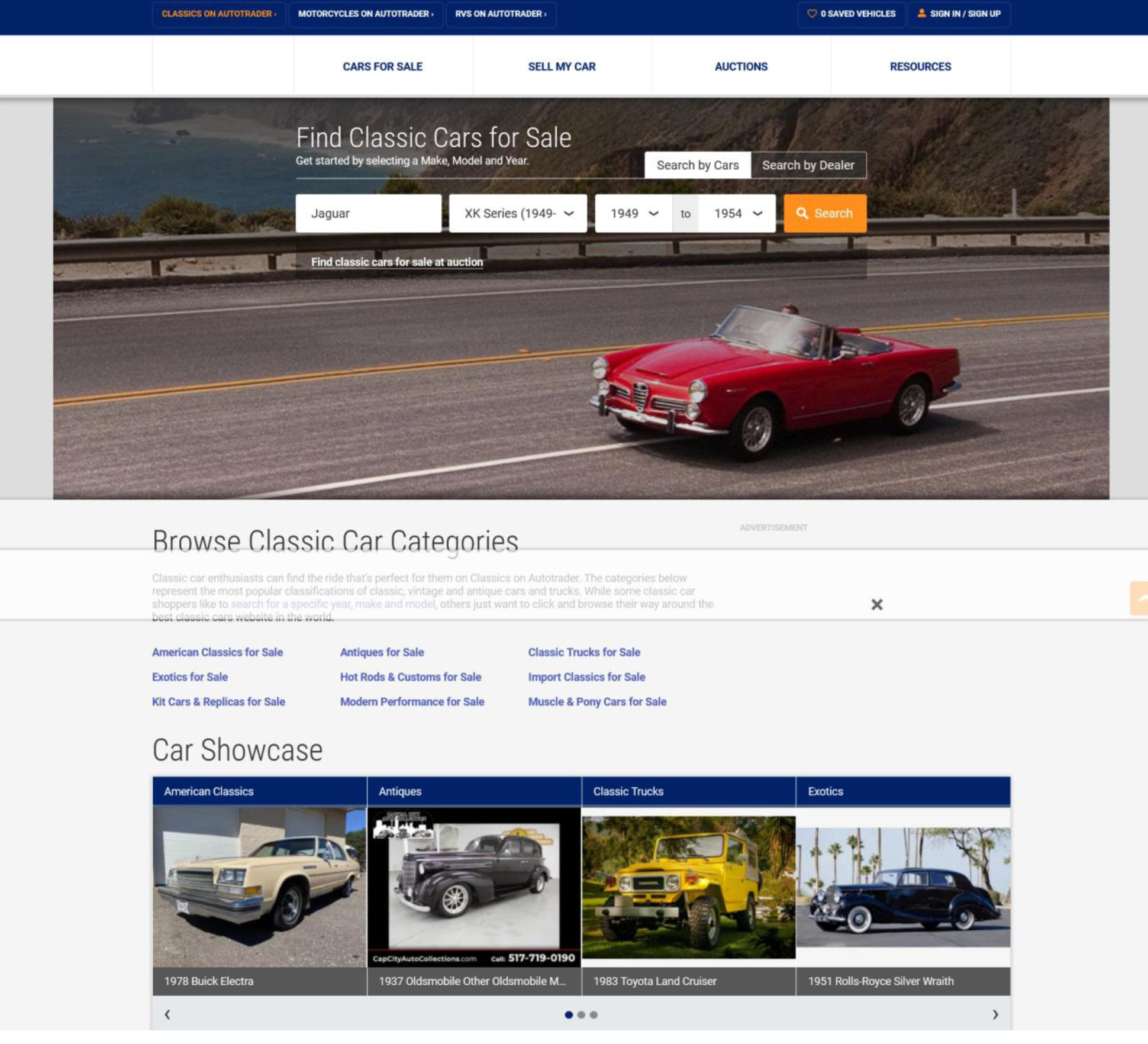
Autotrader.com website
For Autotrader.com the fee for placing an ad depends on the term and ranges between $40 and $100.
Classiccar.com offers a site functionally similar to Classics.Autotrader.com but provides a dedicated site rather than an offshoot from the main site. As such classiccars.com is probably a better bet for your tri-five Chevy.
On-line auction sites have truly been where the action is. Established with an offering of three cars in 2014, the Bring a Trailer on-line auction has become the gold standard of digital on-line auction platforms. This year BaT has over 450,000 users and 200,000 bidders. Both figures continue to grow. In 2019 BaT sold over 11,000 cars. In 2020 BaT car sales exceeded $400 million. For 2021 both numbers are trending significantly higher.
While BaT has some issues it is widely considered the go-to site. BaT features an inexpensive listing fee of $99 and an optional added $250 if photo service is desired. With listings running for 7 or 10 days depending on the car, BaT offers a significant benefit for a seller with the ease it provides for posting hundreds of photos of the car from every angle as well as videos showing a walk-around or the car being test driven. No sales website offers that. In theory and most often in practice, this extensive visual reference reduces the need for a distant buyer to personally inspect the car, though a PPI (Pre-purchase Inspection) is always advisable if possible.
A downside to BaT results from its success. First your car must be accepted. Just cause you want to list on BaT does not mean your car will be accepted. A bit of work goes into the submission process. Then, if you want a reserve it requires negotiating with a BaT staff member. Finally if you pass all of the hurdles, you will have to get on a significant line and wait for weeks or months to have your listing posted.
Buyers pay a 5% fee on top of the final sale price to BaT, with a minimum of $250, and capped at $5,000.
Unlike websites with cars for sale the BaT and all other on-line auctions have a bidding process that usually lasts seven days. One nice feature of BaT is that, unlike eBay, sniping with a last second bid is prevented by having two minutes added to the bidding time after any last minute bid.
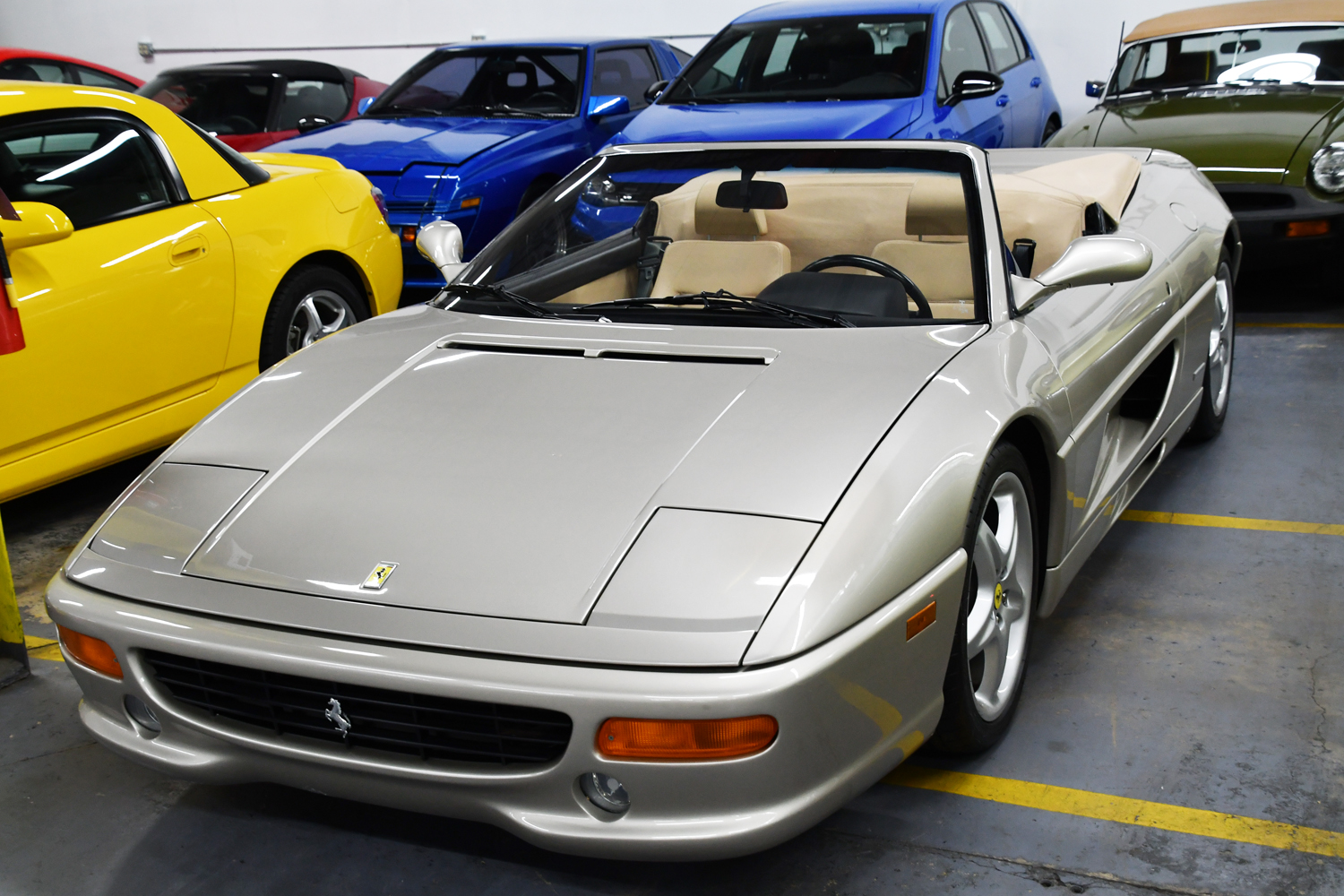
1999 Ferrari 355 Spyder headed for BaT
One element initiated by BaT and unique to on-line auctions is the comments section. Here users can write comments about a car that has been listed. While some comments provide constructive insights about a car, Matt says, “Primarily on Bring a Trailer, you definitely have people bid a $1,000 on a car just so they can claim that they’ve bid on cars before just to do comments. Some of which are just ridiculous. You know they had one situation or heard from a friend. They write as if they were experts. The downside is that you get guys with the negative comments. They could hurt the sale. It takes one comment from a guy trying to sound like an expert that kills the sale.”
On-line auction fees compare very favorably to the 10% to 12% charge common to in-person live auctions.
New on-line auction sites playing off the highly successful BaT model appear on the scene with regularity. The most popular include Cars and Bids, Hemmings, P-Car Market and RADwood. All impart their own special flavor to BaT functionality.
Cars & Bids spun off from the large following of blog personality, the knowledgeable and entertaining, Doug DeMuro. C&B adapts the basic functionality of BaT with its own special treatment. C&B limits itself to listing vehicles it describes as anything cool and exciting from the 1980s to 2020s. As well, playing off the popularity of DeMuro, your vehicle, if selected, will benefit from the extra eyes and extra buyers DeMuro will bring to your listing by reviewing your car on C&B.

Barrett-Jackson Auction
Less expensive than BaT, Cars & Bids buyers pay a 4.5% commission, capped at $4,500. Sellers list for free and receive 100% of the sale price.
Reading the hand-writing on the digital wall, historic friend to the collectible car enthusiast, Hemmings, entered the on-line auction fray in 2019. Basically conforming to the Bat functionality with less of the BaT panache, Hemmings Auctions offers anyone listing on the auction six months of Hemmings classified ad space for free if the car does not sell at auction during its 14-day listing. To qualify for a Hemmings auction, the car must be roadworthy and you must submit to an assessment with a listing specialist.
Hemmings auction listings offer an eclectic mix of vehicles across a range with some modern but usually more classic cars including brass era every once in a while. Listing backlog is usually two to three weeks. Far better than BaT. The seller’s cost to list is $99.95. Buyers pay 5% with a minimum of $500 and a $10,000 maximum.
P-Car Market initially started as a dedicated Porsche site, but now, they do everything. Sellers have a choice of listing options and associated fees ranging from $99 for either a traditional Reserve or No Reserve listing to $500 for a Blind Auction that hides the bid amounts until the reserve is met. Buyers pay a 5% non-refundable buyer’s premium with a (minimum of $500.00 and a maximum of $5,000.
RADwood presents a platform focused on the automotive lifestyle and culture of the 80s and 90s. It will list cars, trucks and motorcycles from 1980 through 1999. Sellers pay from $45 to $125 based on the terms of the listing. Duration ranges from 7 to 10 days. Buyers pay 4.5% with a minimum hold of $150 and a maximum of $4500.

Mecum Auction
In-Person live auctions represent the red carpet events of the classic car selling world. Gooding, R&M Sothebys, Bonhams, Barrett-Jackson, Russo & Steel and Mecum represent the big players with many other smaller operations filling the field. The big auctions present elaborate shows rich with theatrics and a robust party atmosphere often tied to a high visibility event such as Amelia or Pebble Beach. Though the auction itself is a destination.
Every auction has a personality expressed by the nature of the cars it fields. Matt says, “Gooding – High end more modern cars, race cars, 1970-80-90. German, M-B, Porsche, Ferrari. Not brass. RM Sothebys – Top notch venue, older vehicles Rolls-Royce, Bentley, Jaguar, a good mix. Bonhams – Similar to RM. Mix, 60s and older, more brass, some RH drive. Barrett-Jackson – Muscle cars or a restomod. Traditional American classic cars. At certain locations. You might be able to get a foreign sports car in there but you’re not selling a 356 Porsche Speedster at Barrett-Jackson. Mecum – basically the same as Barrett-Jackson, except one advantage that makes Mecum different is you can put a reserve on a car where at Barrett-Jackson you can’t. Russo & Steel – Mix, modern, high mileage Ferraris.
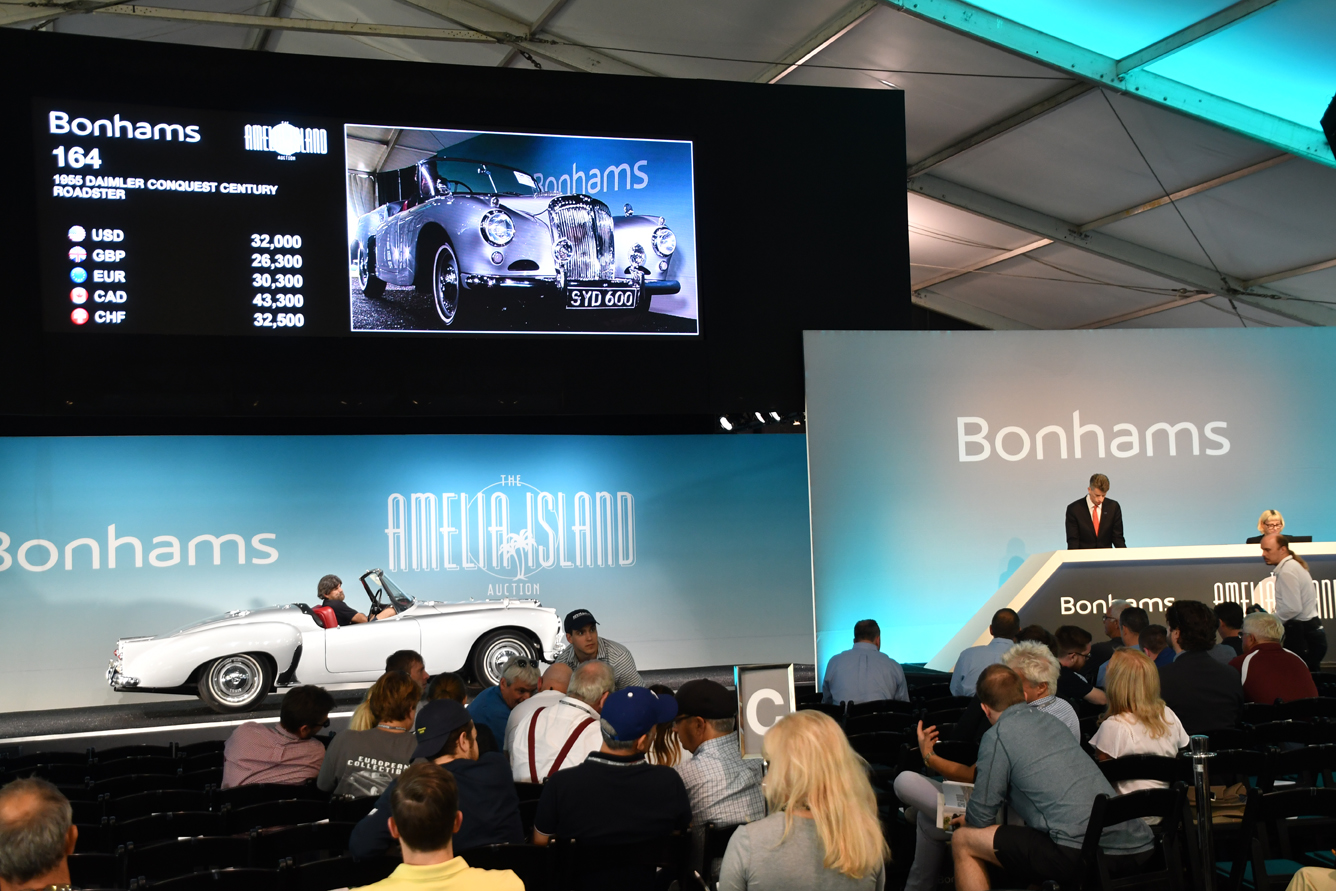
Bonhams Auction
Live In-Person auctions possess a visceral electricity because you have buyers in the room. Matt says, ”The buyers are there nine times out of ten. They do have bidders on the internet and on the phone, but essentially the buyers are there.” Auction houses typically do a great job in marketing. They will market an event, three to four months in advance. Matt says, “They’re going to market individual cars as well as the event itself. For example, look at this great Bugatti that’s going to be auctioned.”
At an In-Person Live auction the auctioneers are professionals and experts in their field. They have gone through every car and know everything about each specific car going through auction. Matt says, “A potential bidder can ask them a million questions without having to go to the owner where the owner is emotionally attached to the car and might embellish things. The auctioneer will tell you everything you want to know without any of the stories, smoke, and mirrors.
Here one can find the truly unique and special high value vehicles. Matt says, “Chances are the individual considering buying that car already knows about that car. They already know who owns it. Now that potential bidder may talk to the auctioneer and discuss everything about that car. He might be able to take it for a test drive. The auctioneer is going to relate the entire history of the car. And again, these cars are vetted by the auction house. They’ve gone through it. They know everything about it. They’re not going to put in a Bugatti that potentially is not a real Bugatti.”
While it is often felt that a vehicle can sell for more at an In-Person Live auction, compared to other platforms buyers fees are considerable. Until recently the buyer’s premium stood at ten percent. Matt says, “Now from my understanding certain locations have gone up to 12%. It depends on where. Scottsdale is 12%. I think Amelia Island is 12%. I’m going to say, Greenwich is probably still 10 percent.”
Regardless of the platform selected when looking to purchase a collectible vehicle the best advice is to do your research, make a plan, set a budget and, most important, exercise discipline.
